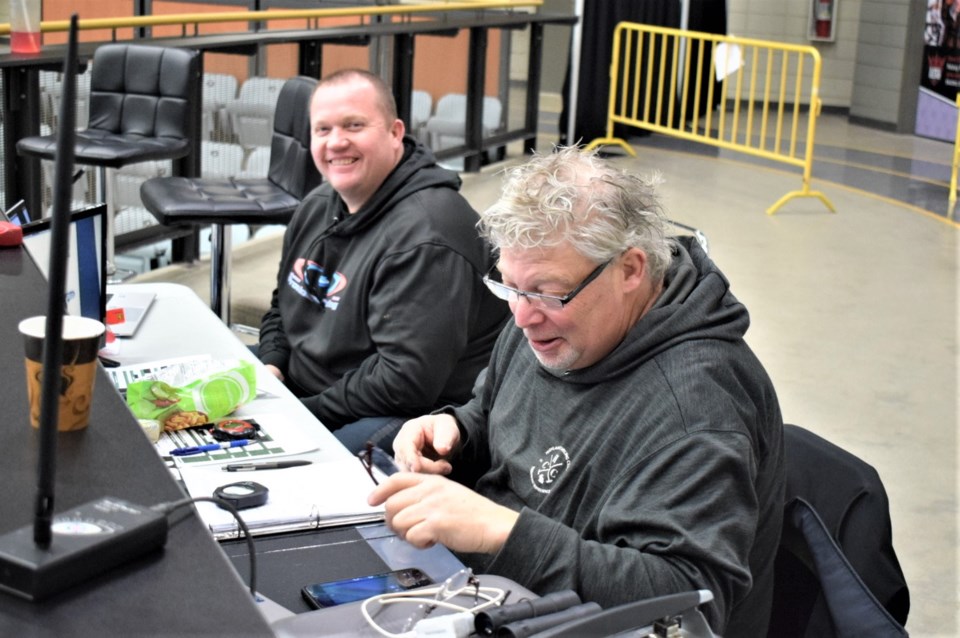ESTEVAN - The curlers, the CurlSask representatives, the organizing committee and the fans have been thrilled with the ice conditions at the Scotties-Tankard provincial curling championships in Estevan.
And that’s music to the ears of Darren Gress, Jayson Braaten and Jason Reddekopp.
The three men are the icemakers for the provincials, with Gress the head ice man. And they are quick to point out they have a number of local people helping them with making and creating great ice.
Gress has roughly 40 years of ice-making experience working out of the Highland Curling Club, and Braaten, who resides in the Abbey area north of Swift Current, has been doing it for even longer. Both have lots of experience with CurlSask and Curling Canada events.
Reddekopp has about a dozen years of experience working with the Spiritwood club.
Gress is a life-long curler at the Highland. When he was 18, the club was looking for an icemaker, and they asked him if he was interested. He was out of high school, working at a golf course and decided to start making ice for winter employment.
“It was … interesting to know how the curling ice was made, and what was going on about it.”
He started working with a number of different top icemakers and learned there was more to great ice than just throwing rocks.
Gress can often seen monitoring a pair of laptop computers. One tracks the temperatures on the ice surface and the slab. With the other, they control the compressors for the ice. It allows them to change the temperatures from their vantage point in a corner of Affinity Place.
The art of creating and maintaining the ice has changed a lot over the years, he said.
“We had straw back in the day, but all our scrape patterns are different, the blades are better, the rocks are better, the temperature-monitoring stuff is better. Back in the day, they never had that, it was more of an educated guess, I would guess, and now it’s more technical.”
The ice has received praise throughout the Viterra Scotties Tournament of Hearts women’s provincials and the SaskTel Tankard men’s event.
“Jay and I have been doing ice for a long time, so it’s good to hear, but we throw rocks on it, too, so we know it’s pretty good. It’s great to have them say it as well. That’s what our goal is, so they can read the ice and there’s no second guessing out there with shots and stuff.”
Braaten believes he first started making ice in 1976. He had just finished university studies and was working on the family farm. That year the Abbey rink installed artificial ice and the local club needed someone to maintain it. Braaten stepped forward.
“The camaraderie is just fantastic, just to be with these guys. Darren and I are the best of friends, but we don’t see each other unless we’re doing these events,” said Braaten.
Spending time at the marquee competitions also gives him the opportunity to get to know the curlers.
“It’s fun to put on a good product, obviously. It’s a lot of hard work but it’s fun to do it,” said Braaten, who said the compliments are appreciated.
“We know we’re doing a good job. It’s like anything, right? You get better at it the longer you do it, and we know the product down there,” said Braaten.
While Gress is doing the tech end of things, Braaten and Reddekopp are watching the speed and the curl of the stones.
“Once the ice is in, it’s just maintaining, obviously. We redo it every draw, and when you’re scraping, you just have somebody watching the blade, and the blade of the scraper is going to tell you what’s up down there. And then obviously we repebble it and nip it, and then we go again.”
They can also be seen maintaining the ice during the fifth end break of each game.
Installation is hard work because they only have a few days to turn hockey ice into curling ice.
“We’ve had tremendous help here from the locals, which is great,” said Braaten.
Braaten remembers being in Estevan in 2001 for the Scotties, and for the Tankard in 2018.
It means a lot of work, but it’s worth it.
There was also work to be done between the end of the Scotties on Sunday and the start of the Tankard on Wednesday, so they didn’t get a day off.
Reddekopp has been an icemaker for about 12 years. He’s been helping Gress and Braaten with everything that needs to be done, and learning as much as possible. He has helped out with seniors and mixed doubles competitions, and some other high-profile events, but this is the first time at a Scotties or a Tankard.
He became an ice maker because his kids were into curling.
“They were looking for someone to help with the ice, so I started and enjoyed it, and just kept going from there,” said Reddekopp.
He enjoys the challenge of making good ice and all of the details that have to be followed. He didn’t realize how tough it was to make top-notch ice.
“Everything makes a difference on it. All your different external conditions make a difference on your playing surface. You have to control all of them, and if you can’t control them, you have to adjust. So there’s a lot to know.”

